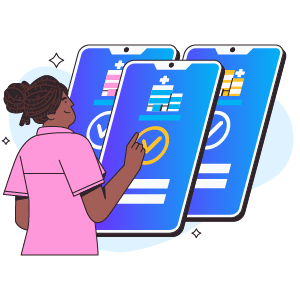Around 50 million essential workers are at risk of infection and death as Americans experience a resurgence of the COVID-19 pandemic. Many of these essential workers are nurses who face health hazards every day while caring for those infected. As the federal government’s response to the pandemic rolls out, hazard pay for nurses remains a critical issue.
Here’s an in-depth look at the all-important issue of hazard pay for nurses during the COVID-19 pandemic.
What is hazard pay?
According to the U. S. Department of Labor, hazard pay is extra compensation for work involving physical hardship or danger. An employee receives hazard pay in addition to their regular paycheck.
Get job matches in your area + answers to all your nursing career questions

How does hazard pay work?
An employer will most often calculate hazard pay based on a flat fee or an increased hourly rate. The total is then added to the worker’s regular salary or wages.
For example, an employer might settle on a 10% premium for every employee working under hazardous conditions. For all the hours such an employee works, they will receive 10% more on top of their hourly pay.
What about workers who are eligible for overtime and are still working in hazardous conditions?
Such worker’s overtime will be calculated based on their total regular pay plus the 10% premium. Even when other exclusions to overtime pay rate calculation apply, hazard pay doesn’t get affected.
In flat rate scenarios, an employer can decide on an amount that will apply per period. For example, if an employer offers $300 a month for hazardous pay, you will receive that on top of your regular paycheck.
It’s important to note that you only receive hazard pay for the hours you work under dangerous conditions.
Hazard pay: what does the law say?
No federal law stipulates that employers must make hazard pay available for their employees. For the most part, hazard pay is an employer’s decision, typically tied to making their organizations more attractive.
Of course, such negotiations will typically happen through collective bargaining with a union. But, that doesn’t mean non-union workers can’t receive hazard pay. Many often do qualify for it as well.
At the state-wide level, there are no laws making hazard pay required for private-sector employers. However, there are a few locales that make hazard pay for local government workers a must. These include Birmingham, Alabama.
Another exception here is several federal statutes that require federal workers who perform particular hazardous tasks to receive hazard pay.
Are nurses currently receiving hazard pay?
In most cases, no. Despite their critical role in beating back the COVID-19 pandemic, few nurses across the United States are receiving hazard pay.
How is this possible?
Let’s set the stage.

Since the COVID-19 pandemic hit, Congress has authorized several relief packages to help stabilize the economy. That’s trillions of dollars going to assist Americans to weather the financial impact of the pandemic.
In all this, not one federal dollar has gone towards paying essential workers on the pandemic front line any form of hazard pay.
On May 15th, 2020, the House of Representatives passed the Health and Economic Recovery Omnibus Emergency Solutions Act (HEROES Act).
Among other things, the bill set aside $200 billion for hazard pay dedicated to essential workers. The Department of Homeland Security (DHS) identified 17 classes of essential workers eligible for the hazard pay.
When the HEROES Act went before the Senate, they didn’t pass it. Instead, the Senate proposed its bill – The Heals Act. And that’s when the deadlock between the two sides began.
Caught in-between were thousands of essential workers who couldn’t benefit from the proposed hazard pay, including nurses.
As the deadlock raged on, some institutions independently decided to implement a type of hazard pay for essential workers. In such cases, nurses would receive a slight premium for working on the frontlines of the COVID-19 pandemic.
However, such bold and innovative decisions have been few and far between. Significantly few nurses have benefited from such independent programs.
How much were nurses set to receive in hazard pay?
The HEROES Act envisaged essential workers receiving $5,000 or $10,000 in hazard pay. That amount was to be paid retroactively.
As such, nurses (as part of the essential workforce) were set to receive a lump sum amount for all the hours worked since January 27th, 2020.
On top of that, every nurse would also receive a $13 hourly hazard pay rise alongside their regular paychecks.
The payout would stop once a nurse reached their $5,000 or $10,000 limit or 60 days after the COVID-19 pandemic ended – Whatever came first.
For nurses earning an average of $35.24 an hour, that would have been a considerable boost to their morale.
Get job matches in your area + answers to all your nursing career questions

Should nurses receive hazard pay?
While it may seem like a straightforward discussion, whether or not nurses should get hazard pay during the COVID-19 pandemic elicits passionate views.
Arguments for nurses receiving hazard pay
Those who believe nurses ought to get hazard pay look at the motivation and financial stability it offers to frontline workers. For this group, the pros of providing nurses with hazard pay include:
1. Not all nurses get hazard pay from their union or institution
Although some nurses may belong to a union or are employed by organizations that are beefing up their financial support, many aren’t.
As such, legislation on hazard pay would go a long way to ease financial pressures such nurses may have during the pandemic.
2. Nurses feel expendable
Before the COVID-19 pandemic hit, nurses were an underappreciated and undervalued lot. With the pandemic ensuing, it’s only exacerbated this feeling.
In particular, the stalemate between the House and Senate has left many nurses feeling they are not a priority. Inevitably, this has had an impact on their morale and output even as they soldier on.
Many supporters see hazard pay for nurses are a critical tool in lifting their spirits and sustaining their motivation, potentially saving more lives.
Nicholas McGowan, BSN, RN, CCRN, and founder of Critical Care Academy is a firm proponent of hazard pay for nurses. He argues that the process nurses must go through just to treat COVID patients is proof alone of the danger involved:
“When I am assigned to care for COVID patients in the ICU, I have to put on personal protective equipment (PPE) which includes a gown, gloves, an N95 respirator, and a face shield prior to entering my patients’ room.”
“Upon exiting, I have to remove and dispose of the gown and gloves, disinfect my hands, put on a new set of gloves, remove my face shield and disinfect it, remove my N95 respirator and set it aside to be reused again, remove my gloves, and finally disinfect my hands again.”
“This process is repeated every time I enter a patient’s room which is an average of 20 to 30 times a day per patient. Any deviation from this process could potentially expose me and therefore my family to the virus.”
Nicholas also re-frames what it means to be a nurse in the era of COVID. He notes, “I continue to show up to work to feed my family and I have a moral and ethical obligation to my patients. I am however no longer a ‘frontline worker’ – I am the last resort. And I am exhausted. Hazard pay won’t make my job any easier or make it feel less “hazardous.” But it might just give me the extra fortitude I need to keep going.”
3. Hazard pay supports skilled workers
Another claim supporters of hazard pay for nurses have is that it helps support valuable skills as much as welfare supports those who need a helping hand.
If the government sees the critical need to support those facing unemployment, especially due to the COVID-19 pandemic, shouldn’t supporting frontline nurses financially be just as critical? For hazard pay proponents, these two things are crucial and deserve equal attention.
Arguments against nurses receiving hazard pay
On the other end of the issue, others feel hazard pay isn’t necessary for nurses. Surprisingly enough, this includes fellow nurses in some cases.
Some of the cons associated with providing nurses hazard pay for this group includes:
1. Nurses are already well paid.
Many people (including fellow nurses) feel that nurses are already well paid. If anything, the hazard pay premium should go towards the poorly paid essential workers who are more at risk and need a buffer.
2. Hazard pay leads to more debt.
A notable fear for many people who don’t see the need for hazard pay for nurses is that it calls for more debt. The more the government has to commit towards paying hazard pay for nurses, the more it has to borrow to meet this commitment.
In the end, it adds to the country’s debt burden. Seeing that nurses earn relatively better than other essential workers, some people feel hazard pay is unnecessary.
3. A sense of duty should drive nurses
For many health organizations, hiring and retaining top nurses became a critical factor when the COVID-19 pandemic hit. Financial incentives play a substantial part in this.
Those who don’t see hazard pay as a critical need for nurses feel that if a nurse can’t be motivated by their sense of duty, they should look for another line of work instead of a greater monetary incentive.
Upcoming developments in nurse hazard pay
While the federal government is still mum on the proposed $200 billion hazard pay plan proposed under the HEROES Act, a few developments offer some hope. Several states have moved to set up hazard pay programs. Pennsylvania, Louisiana, and Vermont have set up a fund to pay private and public sector employees hazard pay through the CARES Act.
Although the impact such programs have is less than what the proposed HEROES Act could achieve, it’s a starting point.
No matter what side of the hazard pay debate you stand on, it’s clear that a viable solution is vital to keep supporting the fight against COVID-19.
Get job matches in your area + answers to all your nursing career questions

